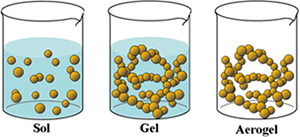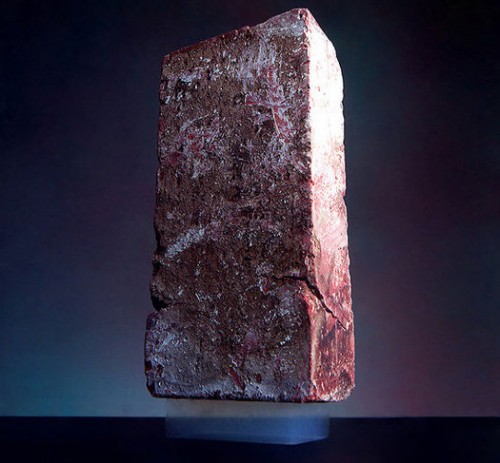Cellulose Aerogel: Strong, Flexible & Magnetic
Image courtesy madsilence.wordpress.com
Three score and ten years ago, a bunch of scientists invented aerogel, a material so air-entrained that it makes angel food cake seem as dense as a lead ingot. As an insulator, aerogel is “four times more efficient than fiberglass or foam … according to Dr. Peter Tsou of NASA’s Jet Propulsion Laboratory, ‘you could take a two- or three-bedroom house, insulate it with aerogel, and you could heat the house with a candle. But eventually the house would become too hot'” (Fox). Aerogel is lightweight, efficient, flameproof, vapor-permeable, and more plastic than fiberglass or foam insulation. And, until recently it has been prohibitively expensive.
Image courtesy Aspen Aerogel
You make aerogel by first constructing a conventional gel, and then replacing the entrained liquid though supercritical drying. If you’re thinking supercritical drying involves some pretty harsh language and a lot of gelatinous tears, think again. The process is “accomplished by increasing the temperature and pressure of the solvent phase inside of the gel structure beyond its critical point. This ‘supercritical’ extraction condition lowers the surface tension between the liquid and the solid pore surfaces so that depressurization of the system at temperatures above the critical temperature leaves the pore structure filled with gas. The resultant material is 90 percent air, but retains the structure and rigidity of the non-liquid gel components” (Source: Aspen Aerogel).
Image courtesy Aspen Aerogel
I’m thinking of this kind of like a salad dressing where you mix oil and vinegar together vigorously, so that tiny droplets of vinegar are suspended in the oil. The supercritical part is that you basically zap the vinegar out and suddenly the oil has tiny pores in it where the acid used to be … only the salad dressing is more solid than oil, really it’s kind of like swiss cheese…. Hmmm maybe the culinary metaphor was the wrong way to go.
Anyway, you might want to grab a chair at this point because you’re not going to believe this next part and you might fall down if you’re standing up because I mean really, who comes up with this stuff???
Researchers (I know not where) decided to soak some cellulose, which is the structural component of plant cells from which we make paper and cardboard, in a solution of metallic nanoparticles (like ya do). In case you’re taking notes, the solution was comprised of iron sulfate and cobalt chloride, so the cellulose fibers took on the properties of metal and became magnetic. Next, in order to turn this crazy wood-metal cocktail into an aerogel the researchers freeze-dried the nanoparticle-infused cellulose, leaving behind a lightweight, moisture-free, porous mesh of solid fibers. This resulted in “a flexible, lightweight, super-absorbent sponge that can also be crushed down into a flat piece of magnetic “nanopaper” capable of supporting 400,000 pounds per square inch” (Dillow). Or to put it another way, it can support the weight of approximately 33 adult male elephants per square inch.
Image courtesy www.popsci.com (The Aerogel is supporting a brick).
The resulting material can be flexed and folded, and it’s highly absorbent. If you hammer the air out of it, you are essentially left with a piece of magnetic paper that can support the weight of the aforementioned elephants. Applications for a “super-strong, flexible, absorbent, magnetic sponge” abound in materials science: for example, it could easily find a home in “microfluidic devices like fuel cells or used to make small actuators” (Dillow). I could also see how it might be incorporated as a filter or used to insulate submarines.
Filing under wood and metal – this was a no-brainer.
Cited:
Dillow, Clay. “New Flexible Cellulose Aerogel is both a Magnetic Sponge and a Flexible Nanopaper” Popsci.com 08/09/10. Accessed 10/26/10. URL.
Fox, Stuart. “Superinsulating Aerogels Arrive on Home Insulation Market at Last” Popsci.com 02/04/10. Acessed 10/26/10. URL.



















We’re testing Thermablok aerogel right now, which is a NASA-developed thermal break tape being used to short-circuit thermal leaks through metal stud framing in commercial construction. The Thermablok is applied to the metal studs prior to application of the exterior cladding system, is incompressible, and provides an R-value of 10.3 per inch of thickness. Their standard thickness is 3/8 inch, and it is a nice alternative to full foam board attached outside the studs, commonly known as EIFS, since foam production is a nasty process and it’s the thermal short-circuiting at the studs that’s the real problem.
[…] third of the material breaking down within 30 days” (Physorg.com). You can read more about aerogel […]
[…] is as light as a feather and as an insulator it makes whale blubber look pathetic (please do read this post for more on the awesome characteristics of […]
[…] In fact, “with a density of just 0.9 mg/cm3 the material is around 100 times lighter than Styrofoam and lighter than … ‘multiwalled carbon nanotube (MCNT) aerogel’ – also dubbed ‘frozen smoke’ – with a density of 4 mg/cm3″ (Quick). Learn more about aerogels here. […]
Leave a Wordpress Comment:
Ads
Watch ARCHITERIALS Videos on vimeo
Like on Facebook
Twitter
Flickr
Hit Counter
Ads
Blogs
Green
Journals/Publications
Materials
Network/News
Offices/People
Resources
Science
Pages
Archive
RSS and Email Subscriptions
Tag Cloud
3D 3D printer AB FAB academic acid acrylic actuated matter adaptive adhesive adsorption aerogel air air conditioning alloy aluminum amnh antibacterial antifungal ants april fool's architecture architecture robot artificial skin autonomous aviation awesome bacteria bamboo bananas beer bench bend bending biennale biocomputing biodegradable biodegradeable biomaterials biomimetics biomimicry biominerals biopolymer birds blast blast-resistant block blocks blogs Bloom Box brazil brick bubbles bucky bulk metallic glass butterfly calera canvas carbon carbon fiber carbon nanotubes carpet cars ceiling cellulose cement ceramic chain link chair charcoal charlie sheen chemicals chiller clay cloth cloud cmu coils color color-changing communication compound computer concrete condensation conducting conductive context cool coral cracks crystal cyborg demakersvan design digifab dirt disaster dna dror drywall dutch dynamic EAP earth ecocradle ecolect e coli ecology ecoresin ecovative elastic electric electricity electrochromic electroluminescent electronic energy energy recovery environment evaporative cooling experiment fabric fabrication facade fiber fiberglass fiber optic fiber optics fibers film FIRE flexible flickr fly ash foam fungus furniture garbage gel geodesic dome geometry gfrp gilgamesh glass glass fiber glow glue gold graphene green greensulate gsapp gypsum hard heat heavy heidi klum helix hemp hexagon hidden high performance hive honeybee humidity ice India ink insulation interference Internet inventables invisible invisible ink jello jellyfish just add water kevlar kinetic korea lace lamboo laser lattice leaves LED leed LEGO light light emitting light transmitting liquid lo mein london Loop.pH machines magic magnetic marine material materials meatball melting memory metabolic engineering METAL metal panel metamaterial micro microsensor microtools military milk MIT moisture multi-layer mushrooms mycelium nano nanogel nanotech nanotubes NASA new noise non-metallic oil OLED OMA ostrich oysters packaging paint panel panels paper paperfoam paraffin wax particles particulates petroleum phase change phosphorescent pink PLA plastic platinum pm-10 poetry pollution polymer polymers porcelain power precast printed printing protein public quadror radiant rain rammed earth reclaimed recycled reflective refracting Rem Koolhaas resin robot robotics roof rubber rugged sand sealant sealer search segmented self-healing sensor shape memory silica silicon silk skin skittles slats smog soft solar solar cell solar cells solar paint solid solid state lighting sound spider spider glue spray stabilized sand stone stretch stretchable strong structural structure studio dror sun sunglasses super supercritical sustainable switzerland tags tape technology TED tensile TEXAS textile textiles texture thermal thermochromatic thin thin film thread tiger stone tile tiles timber tio2 tires toaster tokujin yoshioka touch touch-sensitive toxic transparent t shirts tulip ultra-thin university of akron university of connecticut upcycling virus voc wall wallpaper WATER web wet whale wires WOOD woodwool wool workshop
WP Cumulus Flash tag cloud by Roy Tanck and Luke Morton requires Flash Player 9 or better.
Recent Comments
Ads
Recent Posts
Most Commented
Most Viewed